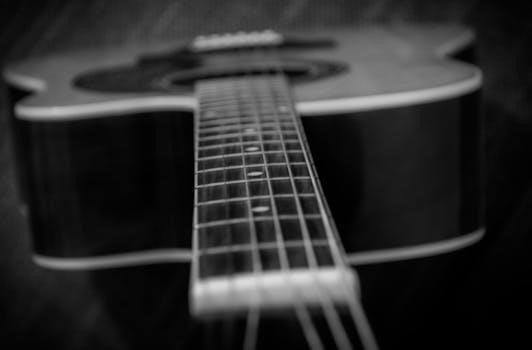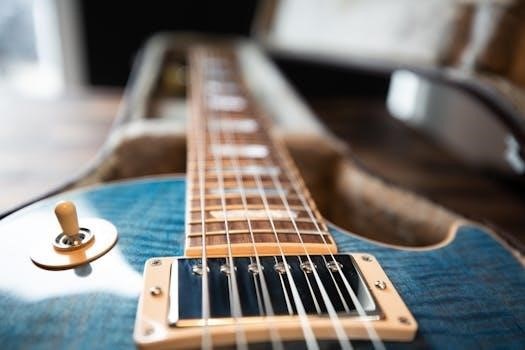Guitar Chord PDF⁚ An Overview
A guitar chord PDF offers a visual resource for learning chords. These PDFs use diagrams and pictures to show finger placements. They help beginners understand basic chords, while also providing resources for more advanced guitarists.
Basic Chord Visuals and Diagrams
Guitar chord PDFs often present chords using visual diagrams. These diagrams typically show the guitar neck, with strings represented as vertical lines and frets as horizontal lines. Dots or numbers on the diagram indicate where to place your fingers. An “x” above a string means it should not be played, while an “o” represents an open string. These visuals are crucial for beginners, helping them understand finger placement and chord shapes quickly. Diagrams are usually coupled with chord names, such as ‘C Major’ or ‘A Minor’, allowing learners to associate visual shapes with the correct sound and name of the chord. The diagrams offer a simplified way to learn and memorize chord fingerings.

Understanding Chord Charts
Chord charts are essential for guitarists. They utilize boxes and symbols to represent chords. Learning to read these charts is crucial for understanding how to play various chords on the guitar.
Reading Chord Boxes
Chord boxes, often found in guitar chord PDFs, are diagrams that represent the guitar fretboard. They show six vertical lines for the strings and horizontal lines for the frets. Numbers indicate which fingers to use. ‘X’ symbols mean a string is not played, while ‘O’ means an open string is played. These visual aids are very helpful when learning new chords. Understanding these elements is crucial to playing chords correctly. The dots show where your fingers should go on the fretboard, helping you to form each chord effectively. These boxes help you learn finger positions, making the learning process easier.
Chord Symbols and Notation
Guitar chord PDFs often use specific symbols and notations. These include letters representing chord names, such as ‘C’ for C major, ‘Am’ for A minor, and ‘G7’ for G dominant seventh. Numbers can indicate finger placement, while ‘x’ and ‘o’ symbols denote muted and open strings. Understanding these notations is essential for reading chord charts correctly. These symbols allow musicians to communicate chord information effectively. They provide a universal way to understand chord structures. Learning these symbols will allow you to quickly learn new chords. This is important when learning new songs.

Essential Guitar Chords
Essential guitar chords form the foundation of playing. These often include major and minor chords. Learning these basic chords is crucial for beginners. They enable you to play various songs and start creating music.
Beginner Chords⁚ C, G7, and More
Starting with fundamental chords is key for novice guitarists. The C major chord is often one of the first learned, utilizing only five strings. The G7 chord is also essential for early progressions, and typically follows the C chord. Other beginner chords like D minor, A major, and F major are also commonly taught. These chords, along with E7, D major, and E minor, enable students to play many songs. Mastering these basic chords, including A7, G major, and A minor, is crucial for developing a good foundation. Diagrams in a guitar chord PDF help visualize finger placements for these basic shapes.
Major and Minor Chords
Understanding the difference between major and minor chords is fundamental to playing guitar. Major chords typically sound bright and happy, while minor chords convey a sad or melancholic feeling. A guitar chord PDF will display these chords, often in root position. Common major chords include C, G, and A, while examples of minor chords are Dm, Em, and Am. Learning to play both types of chords is essential for expanding your musical vocabulary. These chord diagrams show finger positions clearly, making it easier for beginners to grasp. Mastering major and minor chords is crucial for playing a wide range of songs and musical styles.
Barre Chords
Barre chords are essential for guitarists, allowing you to play different chords by moving the same finger shape up and down the neck. These chords are versatile and crucial for various musical styles.
Movable Barre Chord Shapes
Movable barre chord shapes are a cornerstone of guitar playing, providing a flexible way to play chords across the fretboard. These shapes, often based on open chord forms like E and A, can be shifted up or down the neck to create different chords. The root note of the chord is determined by the fret at which the index finger (the barre) is placed. Understanding these movable shapes expands your ability to play in various keys quickly, and is a very important tool for guitarists of all skill levels. Mastering these shapes opens up many possibilities when exploring chord voicings. The ability to quickly change to the desired chord is of great importance when playing. Remember that the lowest note of the chord is always the root, and therefore the key of the chord is defined by the lowest note.

Resources for Learning
Many resources exist for learning guitar chords. Free printable chord sheets and PDF guides are available online. These resources often include diagrams and helpful tips for beginners and experienced players alike.
Free Printable Chord Sheets
Numerous websites offer free printable guitar chord sheets, which are invaluable for beginners and experienced players alike. These sheets typically display common chords, often referred to as “cowboy chords,” in a clear and easy-to-understand format. They frequently include diagrams that show the correct finger placement on the fretboard, making it easier to learn and memorize new chords. Additionally, some resources provide blank chord diagrams, allowing users to document and practice their own chord voicings. These printable sheets are a convenient way to practice and learn various chord shapes without needing access to the internet. They are also helpful for quick reference during practice sessions. These resources are easily accessible and provide a great learning tool for all levels.
PDF Guides and Handbooks
PDF guides and handbooks provide comprehensive resources for learning guitar chords, going beyond basic charts. These resources often include detailed explanations of chord theory, along with diagrams showing finger positions, note names, and intervals. They may cover a wide range of chords, from beginner-friendly options to more advanced voicings like barre chords and power chords. These guides often include tips on how to read chord boxes, and how to use chords in chord progressions. Some handbooks also feature a section on fun and dynamic chord variations not often found elsewhere. These PDF resources are valuable for both beginners and experienced guitarists looking to deepen their knowledge of guitar chords. They offer a structured approach to learning and mastering various chord shapes and techniques.

Advanced Chord Concepts
Advanced chord concepts involve understanding chord progressions and power chords. These go beyond basic chords and explore dynamic and unique chord voicings. These concepts are crucial for expanding your guitar playing skills.
Chord Progressions
Chord progressions are the foundation of most music. They involve a sequence of chords played one after another, creating a harmonic structure. Understanding chord progressions allows guitarists to build songs and improvise melodies. A common progression for beginners is using a combination of C, G, and D chords. Learning to recognize and create progressions is a vital part of guitar playing. Exploring different chord combinations can lead to discovering new and interesting sounds. This concept is critical for songwriting and musical expression. Many resources provide examples and tutorials to help master them. Practicing different progressions will greatly enhance your musicality and guitar skills. You can find them in pdf format.
Power Chords
Power chords are a simplified type of chord, often used in rock and metal music. They typically consist of only two notes⁚ the root and the fifth. Power chords are very easy to play and are movable across the fretboard, making them versatile. They are not technically chords, as they lack a third, but produce a strong, driving sound. Many guitarists start with power chords due to their simplicity. They are also a base for building more complex riffs and solos. Power chords are very useful in many musical styles. They are a fundamental element of rock and heavy metal guitar playing. They are represented in chord charts and pdfs for easy learning.



